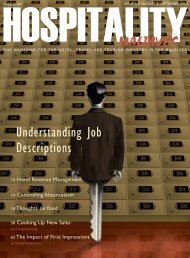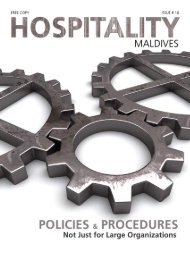Don't Let Your Systems Drive Your Customers Crazy! - Hospitality ...
Don't Let Your Systems Drive Your Customers Crazy! - Hospitality ...
Don't Let Your Systems Drive Your Customers Crazy! - Hospitality ...
You also want an ePaper? Increase the reach of your titles
YUMPU automatically turns print PDFs into web optimized ePapers that Google loves.
HUMAN RESOURCES<br />
Much has been touted about Retention Strategies, Cost Containment<br />
and Talent Management. Some companies are at the forefront<br />
of change and enlightenment; most are not, accepting the<br />
“revolving door” of staff as the cost of doing business. Will this<br />
picture change? Probably not, for the subject has a redundancy<br />
and a long history. When business is good and growth is booming,<br />
few really ever take a long, strategic look. Turnover at an unearthly<br />
rate takes place during upturn as well as downturn. Sadly,<br />
it is part of our <strong>Hospitality</strong> psyche.<br />
But, to affect change, one needs to consider three factors, which<br />
should dictate a retention strategy:<br />
The cost of Turnover<br />
The Labor Pool realities<br />
What your Brand represents<br />
The Cost of Turnover:<br />
Time is money, and your costs accelerate, based upon the level<br />
of the open position and the size of the organization. <strong>Let</strong>’s just<br />
start with the basics. For recruitment, there is the cost of advertising<br />
to begin an applicant flow. The selection process includes<br />
culling through applications, several “cuts” to decide who will<br />
be interviewed, often two to four interviews for the hire decision,<br />
processing time, new hire orientation, and then sufficient on<br />
the job training (which is also down time for the trainer and the<br />
operation). The higher up in the organization the vacancy is, the<br />
greater the cost for the process. For the sake of this example, let’s<br />
use $300 for entry level, $2,500 for Salaried/Middle Management,<br />
and $10,000 for Senior/Executive Management. Do the math on<br />
your own operation, appreciating that the above costing assumption<br />
is very conservative. That is money walking out the door!<br />
Labor Pool Realities:<br />
Consider first the Generational Differences. There are the Matures<br />
(1909-1945), who used to believe in “cradle to grave” employment,<br />
now totally disillusioned. Then the Boomers (1946-<br />
1964), beaten up by the marketplace, transitioned, downsized,<br />
darkly skeptical. Next, the Generation X’ers (1965-1978), who<br />
want a balance in their lives, crave good communications, and approach<br />
work like 1099’ers. Lastly, there are the Millenials (1979-<br />
1988), who want it their way, now. The “onion” layers are just<br />
beginning, for a hard look at the further demographics show, for<br />
the bulk of the <strong>Hospitality</strong> Workforce, a heavily female population,<br />
mostly immigrant with different cultures and languages,<br />
less educated, feeling quite disenfranchised. What a tough market<br />
from which to draw!<br />
What <strong>Your</strong> Brand Represents:<br />
Well, we are in the Experience Era, and we know that our Guests<br />
and patrons look for value, uniqueness, high level service, a quality<br />
product and exceptional delivery. Our Brand is our story, and<br />
we promote ourselves like crazy to entice that wary Consumer.<br />
And, we depend upon our Ambassadors, our worthy staff, to<br />
make the Experience memorable. They represent our interests<br />
and dictate our success. But, wait a moment, there is a disconnect.<br />
Fifty percent of our people are leaving, their departure is<br />
costing us money, and the replacement effort is ever more challenging.<br />
If this does not move <strong>Hospitality</strong> Businesses to establish<br />
a forthright Retention Strategy for 2006 and beyond, we deserve<br />
the reputations we invite and the devaluation of our product and<br />
service. Most bemoan the obvious; few take the initiative. But,<br />
for those who see the situation as critical, consider some of the<br />
following components for a successful Retention Approach.<br />
Retention Strategy:<br />
“A fair days work…” This simple phrase has immense implications.<br />
To perform, our employees need the tools, the direction,<br />
the encouragement, and the environment in which to achieve.<br />
1.<br />
2.<br />
Why are people leaving? <strong>Your</strong> Human Resources offices<br />
should be doing Exit Interviews. The information gleaned<br />
from these exercises often demonstrates problems and<br />
reasons with an easy fix apparent.<br />
What do your current employees feel about the organization?<br />
Employee Surveys do surface information about the<br />
organization and items which are actionable. Do not survey<br />
if you are not prepared to address the issues.<br />
3. Communication. <strong>Your</strong> workforce is diverse, and your<br />
communication systems and mechanisms must recognize the<br />
audience.<br />
4.<br />
5.<br />
6.<br />
Work environment. A quick look at your employee locker<br />
room is often indicative the value you place on the staff.<br />
<strong>Your</strong> employees want and deserve respect, involvement and<br />
particularly leadership.<br />
Training and Development. We must provide the necessary<br />
tools to perform the current job and opportunity to improve<br />
the skill set and ability to move onward in the organization.<br />
“…for a fair days pay”.<br />
Retention is impacted by reward, and this starts with a<br />
meaningful compensation package, both wage/salary and<br />
benefits. You get what you pay for! Additionally, there is a<br />
requirement for recognizing and rewarding performance<br />
excellence.<br />
“ Why are people leaving?<br />
<strong>Your</strong> Human Resources<br />
offices should be doing<br />
Exit Interviews. ”<br />
Conclusion<br />
This is not rocket science or even Best Practices — this is just<br />
common sense. The answers have been around for generations,<br />
however, the impetus, always hovering, was seldom grasped. <strong>Your</strong><br />
employees are just as discerning as your Guests. We have been<br />
smacking crocodiles, and the swamp becomes deeper, murkier<br />
and more deadly. The numbers do not lie; matter of fact, a good<br />
Retention Strategy is more than supported by the money saved<br />
on Turnover. We all tend to look over that fence, admire the<br />
landscaping and the greener grass we assume is the better alternative.<br />
Tend to your own yard properly, and you can put the neighborhood<br />
to shame!<br />
John Hendrie, is CEO of <strong>Hospitality</strong> Performance, Inc., a full-service hospitality<br />
consulting company. With a strong background in <strong>Hospitality</strong>, Human Resources,<br />
Organizational Effectiveness, and Communications, John has devoted his career to<br />
establishing Standards of Excellence across varied businesses. For more information,<br />
please visit www.hospitalityperformance.com<br />
HOSPITALITY MALDIVES OCTOBER/NOVEMBER 2006 47

















